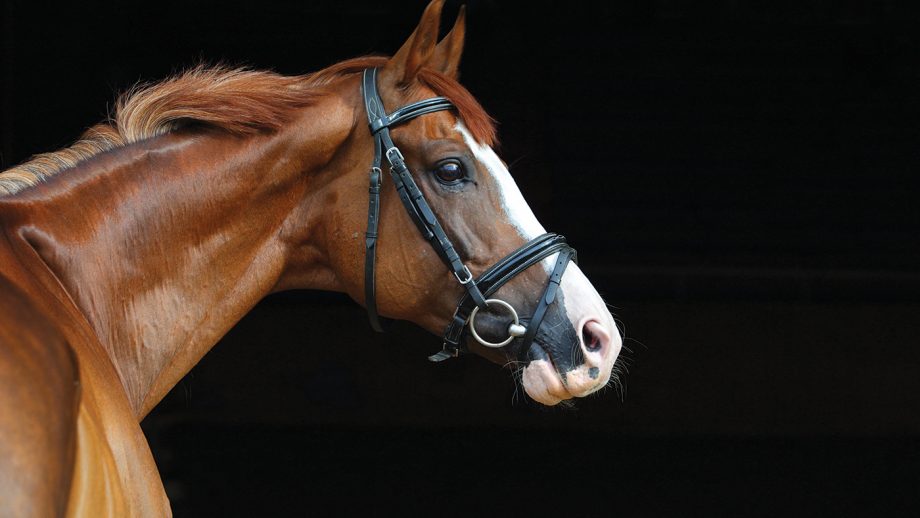Research is proving that bridle pressure can inhibit a horse’s performance, but what’s key to a perfect fit? Dr Rachel Murray MRCVS explains
RECENT developments in technology are enabling us to understand more about the effects of the bridle. Investigations using under-bridle pressure mats are revealing that bridle design and fit can significantly affect a horse’s movement pattern – and therefore his ability to perform.
The nature of equine anatomy means that certain areas of the head are vulnerable to pressure. The better the design and fit of the bridle, the lower the pressure in these areas and the fewer the locations where pressure points can be seen.
At the sites where pressure does occur, this is unlikely to be continuous and will vary depending on the point in the stride. Additionally, depending
on the position of the horse’s head, the location of maximal pressure can vary.
{"content":"PHA+V2hlbiBhIGhvcnNl4oCZcyBoZWFkIGlzIG1vcmUgdmVydGljYWwsIGZvciBleGFtcGxlLCBncmVhdGVyIHByZXNzdXJlIHRlbmRzIHRvIG9jY3VyIGF0IHRoZSB0b3AgZWRnZSBvZiB0aGUgbm9zZWJhbmQgKG5lYXJlc3QgdGhlIGV5ZXMpLiBQcmVzc3VyZSBpcyBtb3JlIGxpa2VseSB0byBvY2N1ciB1bmRlciB0aGUgYm90dG9tIGVkZ2Ugd2hlbiB0aGUgaGVhZCBpcyBtb3JlIGhvcml6b250YWwuPC9wPgo8cD5QcmVzc3VyZXMgYXJlIHVzdWFsbHkgaGlnaGVyIGR1cmluZyBmYXN0ZXIgcGFjZXMsIG9yIHdoZW4gbW92ZW1lbnQgaXMgbW9yZSBleHRyYXZhZ2FudCwgbWVhbmluZyB0aGF0IGdvb2QgYnJpZGxlIGZpdCBhbmQgZGVzaWduIGFyZSBlc3BlY2lhbGx5IGltcG9ydGFudCBmb3IgdGhlIHBlcmZvcm1hbmNlIGhvcnNlLiBIb3dldmVyLCBwcmVzc3VyZSBwb2ludHMgY2FuIG9jY3VyIHdpdGggYW55IGhvcnNlLCB3aGF0ZXZlciBoaXMgam9iLCBzbyB0aGUgYnJpZGxlIG11c3QgYmUgZml0dGVkIGFuZCBjaGVja2VkIGFzIGNhcmVmdWxseSBhcyB0aGUgc2FkZGxlLjwvcD4KPHA+PGRpdiBjbGFzcz0iYWQtY29udGFpbmVyIGFkLWNvbnRhaW5lci0tbW9iaWxlIj48ZGl2IGlkPSJwb3N0LWlubGluZS0yIiBjbGFzcz0iaXBjLWFkdmVydCI+PC9kaXY+PC9kaXY+PHNlY3Rpb24gaWQ9ImVtYmVkX2NvZGUtMzEiIGNsYXNzPSJoaWRkZW4tbWQgaGlkZGVuLWxnIHMtY29udGFpbmVyIHN0aWNreS1hbmNob3IgaGlkZS13aWRnZXQtdGl0bGUgd2lkZ2V0X2VtYmVkX2NvZGUgcHJlbWl1bV9pbmxpbmVfMiI+PHNlY3Rpb24gY2xhc3M9InMtY29udGFpbmVyIGxpc3RpbmctLXNpbmdsZSBsaXN0aW5nLS1zaW5nbGUtc2hhcmV0aHJvdWdoIGltYWdlLWFzcGVjdC1sYW5kc2NhcGUgZGVmYXVsdCBzaGFyZXRocm91Z2gtYWQgc2hhcmV0aHJvdWdoLWFkLWhpZGRlbiI+DQogIDxkaXYgY2xhc3M9InMtY29udGFpbmVyX19pbm5lciI+DQogICAgPHVsPg0KICAgICAgPGxpIGlkPSJuYXRpdmUtY29udGVudC1tb2JpbGUiIGNsYXNzPSJsaXN0aW5nLWl0ZW0iPg0KICAgICAgPC9saT4NCiAgICA8L3VsPg0KICA8L2Rpdj4NCjwvc2VjdGlvbj48L3NlY3Rpb24+PC9wPgo8aDM+VklUQUwgQURKVVNUTUVOVFM8L2gzPgo8cD5USEUgbW9yZSBzdGFibGUgYSBicmlkbGUgaXMgb24gYSBob3JzZeKAmXMgaGVhZCwgdGhlIGxlc3MgbGlrZWx5IGhlIGlzIHRvIGV4cGVyaWVuY2UgcHJlc3N1cmUgcG9pbnRzIGF0IHRoZSBmcm9udCBhbmQgYmFjayBvZiB0aGUgaGVhZHBpZWNlLCBvciBydWJzIGF0IHRoZSBjb3JuZXJzIG9mIGhpcyBtb3V0aCBhcyB0aGUgYml0IG1vdmVzLjwvcD4KPHA+U29tZSDigJxnaXZl4oCdIGlzIG5lZWRlZCBpbiB0aGUgbm9zZWJhbmQsIGhvd2V2ZXIsIGFzIHRoZSBoZWFkIG1vdmVzLiBTaW5jZSB0aGUgbm9zZWJhbmQgaXMgYXR0YWNoZWQgb3ZlciB0aGUgdG9wIG9mIHRoZSBoZWFkLCBpdCBjYW4gYWN0IGFzIGEgZml4ZWQgdW5pdDsgdGhpcyBjYW4gdGhlbiBjcmVhdGUgcHJlc3N1cmUgcG9pbnRzIG9uIHRoZSBwb2xsIGFuZCBhbHNvIHVuZGVybmVhdGggdGhlIGhvcml6b250YWwgZml0dGluZywgcGFydGljdWxhcmx5IGlmIGRvbmUgdXAgdGlnaHRseS48L3A+CjxwPjxkaXYgaWQ9ImF0dGFjaG1lbnRfNzQ2MTUxIiBzdHlsZT0id2lkdGg6IDE0MTBweCIgY2xhc3M9IndwLWNhcHRpb24gYWxpZ25ub25lIj48aW1nIGZldGNocHJpb3JpdHk9ImhpZ2giIGRlY29kaW5nPSJhc3luYyIgYXJpYS1kZXNjcmliZWRieT0iY2FwdGlvbi1hdHRhY2htZW50LTc0NjE1MSIgY2xhc3M9Imxhenlsb2FkIGJsdXItdXAgc2l6ZS1mdWxsIHdwLWltYWdlLTc0NjE1MSIgZGF0YS1wcm9jZXNzZWQgc3JjPSJodHRwczovL2tleWFzc2V0cy50aW1laW5jdWsubmV0L2luc3BpcmV3cC9saXZlL3dwLWNvbnRlbnQvdXBsb2Fkcy9zaXRlcy8xNC8yMDE3LzAzL25ldy1oaC1wbGFjZWhvbGRlci0yMDB4MjAwLnBuZyIgZGF0YS1zcmM9Imh0dHBzOi8va2V5YXNzZXRzLnRpbWVpbmN1ay5uZXQvaW5zcGlyZXdwL2xpdmUvd3AtY29udGVudC91cGxvYWRzL3NpdGVzLzE0LzIwMjEvMDUvSEFIMzA2LnZldF8uZHhlYjBkX2FsYW15LmpwZyIgYWx0PSJEWEVCMEQgRG9tZXN0aWMgSG9yc2Ugd2l0aCBwbGFpdGVkIG1hbmUuIE5ldyBaZWFsYW5kIiB3aWR0aD0iMTQwMCIgaGVpZ2h0PSI3ODgiIGRhdGEtc2l6ZXM9ImF1dG8iIGRhdGEtc3Jjc2V0PSJodHRwczovL2tleWFzc2V0cy50aW1laW5jdWsubmV0L2luc3BpcmV3cC9saXZlL3dwLWNvbnRlbnQvdXBsb2Fkcy9zaXRlcy8xNC8yMDIxLzA1L0hBSDMwNi52ZXRfLmR4ZWIwZF9hbGFteS5qcGcgMTQwMHcsIGh0dHBzOi8va2V5YXNzZXRzLnRpbWVpbmN1ay5uZXQvaW5zcGlyZXdwL2xpdmUvd3AtY29udGVudC91cGxvYWRzL3NpdGVzLzE0LzIwMjEvMDUvSEFIMzA2LnZldF8uZHhlYjBkX2FsYW15LTMwMHgxNjkuanBnIDMwMHcsIGh0dHBzOi8va2V5YXNzZXRzLnRpbWVpbmN1ay5uZXQvaW5zcGlyZXdwL2xpdmUvd3AtY29udGVudC91cGxvYWRzL3NpdGVzLzE0LzIwMjEvMDUvSEFIMzA2LnZldF8uZHhlYjBkX2FsYW15LTYzMHgzNTUuanBnIDYzMHcsIGh0dHBzOi8va2V5YXNzZXRzLnRpbWVpbmN1ay5uZXQvaW5zcGlyZXdwL2xpdmUvd3AtY29udGVudC91cGxvYWRzL3NpdGVzLzE0LzIwMjEvMDUvSEFIMzA2LnZldF8uZHhlYjBkX2FsYW15LTEzNXg3Ni5qcGcgMTM1dywgaHR0cHM6Ly9rZXlhc3NldHMudGltZWluY3VrLm5ldC9pbnNwaXJld3AvbGl2ZS93cC1jb250ZW50L3VwbG9hZHMvc2l0ZXMvMTQvMjAyMS8wNS9IQUgzMDYudmV0Xy5keGViMGRfYWxhbXktMzIweDE4MC5qcGcgMzIwdywgaHR0cHM6Ly9rZXlhc3NldHMudGltZWluY3VrLm5ldC9pbnNwaXJld3AvbGl2ZS93cC1jb250ZW50L3VwbG9hZHMvc2l0ZXMvMTQvMjAyMS8wNS9IQUgzMDYudmV0Xy5keGViMGRfYWxhbXktNjIweDM0OS5qcGcgNjIwdywgaHR0cHM6Ly9rZXlhc3NldHMudGltZWluY3VrLm5ldC9pbnNwaXJld3AvbGl2ZS93cC1jb250ZW50L3VwbG9hZHMvc2l0ZXMvMTQvMjAyMS8wNS9IQUgzMDYudmV0Xy5keGViMGRfYWxhbXktOTIweDUxOC5qcGcgOTIwdywgaHR0cHM6Ly9rZXlhc3NldHMudGltZWluY3VrLm5ldC9pbnNwaXJld3AvbGl2ZS93cC1jb250ZW50L3VwbG9hZHMvc2l0ZXMvMTQvMjAyMS8wNS9IQUgzMDYudmV0Xy5keGViMGRfYWxhbXktMTIyMHg2ODcuanBnIDEyMjB3IiBzaXplcz0iKG1heC13aWR0aDogMTQwMHB4KSAxMDB2dywgMTQwMHB4IiAvPjxwIGlkPSJjYXB0aW9uLWF0dGFjaG1lbnQtNzQ2MTUxIiBjbGFzcz0id3AtY2FwdGlvbi10ZXh0Ij5BIHNoYXBlZCwgbW9yZSBuYXJyb3cgaGVhZHBpZWNlIHdvdWxkIHByb3ZpZGUgYSBiZXR0ZXIgZml0IGFnYWluc3QgdGhlIGVhcnM8L3A+PC9kaXY+PGJyIC8+CjxkaXYgY2xhc3M9ImFkLWNvbnRhaW5lciBhZC1jb250YWluZXItLW1vYmlsZSI+PGRpdiBpZD0icG9zdC1pbmxpbmUtMyIgY2xhc3M9ImlwYy1hZHZlcnQiPjwvZGl2PjwvZGl2PjwvcD4KPHA+SXQgaXMgaW1wb3J0YW50IHRoYXQgdGhlIG5vc2ViYW5kIGlzIG5vdCB0b28gdGlnaHQgb3IgZmFzdGVuZWQgd2l0aCB0aGUgaG9yaXpvbnRhbCBwYXJ0IHRvbyBoaWdoLiBUaGVyZSBzaG91bGQgYmUgc3BhY2UgYmV0d2VlbiB0aGUgbm9zZWJhbmQgYW5kIHRoZSBmYWNpYWwgY3Jlc3QuIFNpZGUgcmluZ3MsIHN1Y2ggYXMgdGhvc2UgdHlwaWNhbGx5IHNlZW4gb24gYSBkcm9wIG9yIGNyYW5rIG5vc2ViYW5kLCBhbGxvdyB0aGUgbm9zZWJhbmQgdG8gbW92ZSBiZXR0ZXIgd2l0aCB0aGUgaG9yc2XigJlzIGhlYWQgYW5kIGNhbiBoZWxwIHJlZHVjZSBwcmVzc3VyZSB1bmRlciBib3RoIHRoZSBub3NlYmFuZCBhbmQgaGVhZHBpZWNlLjwvcD4KPHA+UHJlc3N1cmUgcG9pbnRzIGFyZSBsaWtlbHkgdG8gb2NjdXIgdW5kZXIgYnVja2xlcyBvciBtZXRhbCBmaXR0aW5ncywgcGFydGljdWxhcmx5IGlmIHRoZXNlIGFyZSBsb2NhdGVkIG92ZXIgdGhlIGhpZ2hlci1yaXNrIGxvY2F0aW9ucy4gVGhlc2UgZmFzdGVuaW5ncyBzaG91bGQgYmUgcG9zaXRpb25lZCBjYXJlZnVsbHkgYW5kIHBhZGRlZCB3aGVyZSBwb3NzaWJsZS4gU3RpZmYgbWF0ZXJpYWwgb3IgaGFyZCBlZGdlcyBjYW4gYWxzbyBjcmVhdGUgcHJlc3N1cmUgcG9pbnRzIGFuZCBhcmUgYmV0dGVyIGF2b2lkZWQuIEEgcm9sbGVkIG9yIG5hcnJvdyBub3NlYmFuZCBzdHJhcCB1bmRlciB0aGUgaGVhZHBpZWNlIGNhbiBsb2NhbGlzZSBwcmVzc3VyZSBvdmVyIHRoZSBwb2xsLCBzbyBuZWVkcyB0byBiZSBjYXJlZnVsbHkgY2hlY2tlZC48L3A+CjxwPjxkaXYgY2xhc3M9ImFkLWNvbnRhaW5lciBhZC1jb250YWluZXItLW1vYmlsZSI+PGRpdiBpZD0icG9zdC1pbmxpbmUtNCIgY2xhc3M9ImlwYy1hZHZlcnQiPjwvZGl2PjwvZGl2PjxiciAvPgo8ZGl2IGlkPSJhdHRhY2htZW50Xzc0NjE1MiIgc3R5bGU9IndpZHRoOiAxNDEwcHgiIGNsYXNzPSJ3cC1jYXB0aW9uIGFsaWdubm9uZSI+PGltZyBkZWNvZGluZz0iYXN5bmMiIGFyaWEtZGVzY3JpYmVkYnk9ImNhcHRpb24tYXR0YWNobWVudC03NDYxNTIiIGNsYXNzPSJsYXp5bG9hZCBibHVyLXVwIHNpemUtZnVsbCB3cC1pbWFnZS03NDYxNTIiIGRhdGEtcHJvY2Vzc2VkIHNyYz0iaHR0cHM6Ly9rZXlhc3NldHMudGltZWluY3VrLm5ldC9pbnNwaXJld3AvbGl2ZS93cC1jb250ZW50L3VwbG9hZHMvc2l0ZXMvMTQvMjAxNy8wMy9uZXctaGgtcGxhY2Vob2xkZXItMjAweDIwMC5wbmciIGRhdGEtc3JjPSJodHRwczovL2tleWFzc2V0cy50aW1laW5jdWsubmV0L2luc3BpcmV3cC9saXZlL3dwLWNvbnRlbnQvdXBsb2Fkcy9zaXRlcy8xNC8yMDIxLzA1L0hBSDMwNi52ZXRfLl9kc2M3MDQ0X2Z1dHVyZV9hc3NpZ25tZW50LmpwZyIgYWx0PSIiIHdpZHRoPSIxNDAwIiBoZWlnaHQ9Ijc4OCIgZGF0YS1zaXplcz0iYXV0byIgZGF0YS1zcmNzZXQ9Imh0dHBzOi8va2V5YXNzZXRzLnRpbWVpbmN1ay5uZXQvaW5zcGlyZXdwL2xpdmUvd3AtY29udGVudC91cGxvYWRzL3NpdGVzLzE0LzIwMjEvMDUvSEFIMzA2LnZldF8uX2RzYzcwNDRfZnV0dXJlX2Fzc2lnbm1lbnQuanBnIDE0MDB3LCBodHRwczovL2tleWFzc2V0cy50aW1laW5jdWsubmV0L2luc3BpcmV3cC9saXZlL3dwLWNvbnRlbnQvdXBsb2Fkcy9zaXRlcy8xNC8yMDIxLzA1L0hBSDMwNi52ZXRfLl9kc2M3MDQ0X2Z1dHVyZV9hc3NpZ25tZW50LTMwMHgxNjkuanBnIDMwMHcsIGh0dHBzOi8va2V5YXNzZXRzLnRpbWVpbmN1ay5uZXQvaW5zcGlyZXdwL2xpdmUvd3AtY29udGVudC91cGxvYWRzL3NpdGVzLzE0LzIwMjEvMDUvSEFIMzA2LnZldF8uX2RzYzcwNDRfZnV0dXJlX2Fzc2lnbm1lbnQtNjMweDM1NS5qcGcgNjMwdywgaHR0cHM6Ly9rZXlhc3NldHMudGltZWluY3VrLm5ldC9pbnNwaXJld3AvbGl2ZS93cC1jb250ZW50L3VwbG9hZHMvc2l0ZXMvMTQvMjAyMS8wNS9IQUgzMDYudmV0Xy5fZHNjNzA0NF9mdXR1cmVfYXNzaWdubWVudC0xMzV4NzYuanBnIDEzNXcsIGh0dHBzOi8va2V5YXNzZXRzLnRpbWVpbmN1ay5uZXQvaW5zcGlyZXdwL2xpdmUvd3AtY29udGVudC91cGxvYWRzL3NpdGVzLzE0LzIwMjEvMDUvSEFIMzA2LnZldF8uX2RzYzcwNDRfZnV0dXJlX2Fzc2lnbm1lbnQtMzIweDE4MC5qcGcgMzIwdywgaHR0cHM6Ly9rZXlhc3NldHMudGltZWluY3VrLm5ldC9pbnNwaXJld3AvbGl2ZS93cC1jb250ZW50L3VwbG9hZHMvc2l0ZXMvMTQvMjAyMS8wNS9IQUgzMDYudmV0Xy5fZHNjNzA0NF9mdXR1cmVfYXNzaWdubWVudC02MjB4MzQ5LmpwZyA2MjB3LCBodHRwczovL2tleWFzc2V0cy50aW1laW5jdWsubmV0L2luc3BpcmV3cC9saXZlL3dwLWNvbnRlbnQvdXBsb2Fkcy9zaXRlcy8xNC8yMDIxLzA1L0hBSDMwNi52ZXRfLl9kc2M3MDQ0X2Z1dHVyZV9hc3NpZ25tZW50LTkyMHg1MTguanBnIDkyMHcsIGh0dHBzOi8va2V5YXNzZXRzLnRpbWVpbmN1ay5uZXQvaW5zcGlyZXdwL2xpdmUvd3AtY29udGVudC91cGxvYWRzL3NpdGVzLzE0LzIwMjEvMDUvSEFIMzA2LnZldF8uX2RzYzcwNDRfZnV0dXJlX2Fzc2lnbm1lbnQtMTIyMHg2ODcuanBnIDEyMjB3IiBzaXplcz0iKG1heC13aWR0aDogMTQwMHB4KSAxMDB2dywgMTQwMHB4IiAvPjxwIGlkPSJjYXB0aW9uLWF0dGFjaG1lbnQtNzQ2MTUyIiBjbGFzcz0id3AtY2FwdGlvbi10ZXh0Ij5UaGlzIGhlYWRwaWVjZSBkZXNpZ24sIHdpdGggYSBicm93YmFuZCBvZiBzdWZmaWNpZW50IGxlbmd0aCwgYWxsb3dzIG1vcmUgcm9vbTwvcD48L2Rpdj48L3A+CjxwPkEgbnVtYmVyIG9mIGhpZ2hlci1yaXNrIGxvY2F0aW9ucyBpbnZvbHZlIHRoZSBoZWFkcGllY2U6IGF0IHRoZSBmcm9udCwgd2hlcmUgaXQgcHVzaGVzIGFnYWluc3QgdGhlIGJhc2Ugb2YgdGhlIGVhcnM7IGF0IHRoZSBiYWNrLCB3aGVyZSBpdCBpbXBhY3RzIGFnYWluc3QgdGhlIHdpbmdzIG9mIHRoZSBhdGxhczsgYW5kIHVuZGVybmVhdGgsIG9uIHRoZSB0b3Agb2YgdGhlIHBvbGwuPC9wPgo8ZGl2IGNsYXNzPSJhZC1jb250YWluZXIgYWQtY29udGFpbmVyLS1tb2JpbGUiPjxkaXYgaWQ9InBvc3QtaW5saW5lLTUiIGNsYXNzPSJpcGMtYWR2ZXJ0Ij48L2Rpdj48L2Rpdj4KPHA+QWRkaXRpb25hbCByaXNrIGFyZWFzIGFyZSBzaXR1YXRlZCB1bmRlcm5lYXRoIG9yIGNsb3NlIHRvIHRoZSBicm93YmFuZCBhdHRhY2htZW50cyAocHJlc3N1cmUgcG9pbnRzIGNhbiBvY2N1ciBoZXJlIHdoZW4gdGhlIGhvcnNlIHN3YWxsb3dzLCBvciBtb3ZlcyBoaXMgdG9uZ3VlIG9yIGphdyk7IHVuZGVyIHRoZSBub3NlYmFuZCwgb24gZWl0aGVyIHNpZGUgb2YgdGhlIG5hc2FsIGJvbmU7IGFuZCBvdmVyIHRoZSBqYXdib25lcyBvbiB0aGUgdW5kZXJzaWRlIG9mIHRoZSBjaGluLjwvcD4KPGgzPkZBQ0lORyBGQUNUUzwvaDM+CjxwPlRIRSBmaXQgb2YgYSBicmlkbGUgaXMgYWZmZWN0ZWQgYnkgYSBob3JzZeKAmXMgY29uZm9ybWF0aW9uLiBGZXcgaG9yc2VzIGhhdmUgYSBzeW1tZXRyaWNhbCBoZWFkLCBzbyB0aGUgc2hhcGUgYW5kIGZpdCBvbiBvbmUgc2lkZSBtYXkgbmVlZCB0byBiZSBkaWZmZXJlbnQgdG8gdGhlIG90aGVyLjwvcD4KPHA+VGhlIGRpc3RhbmNlIGJldHdlZW4gdGhlIGNvcm5lciBvZiB0aGUgbW91dGggYW5kIHRoZSBmYWNpYWwgY3Jlc3QgY2FuIHZhcnkuIEEgaG9yc2Ugd2l0aCBhIGxvbmcgbW91dGggYW5kIGEgbG93IGZhY2lhbCBjcmVzdCB3aWxsIGhhdmUgYSB2ZXJ5IHNob3J0IGRpc3RhbmNlIHRvIGFjY29tbW9kYXRlIGEgbm9zZWJhbmQsIHNvIGEgd2lkZSBub3NlYmFuZCBjYW4gY3JlYXRlIHJlYWwgcHJvYmxlbXMg4oCTIGVzcGVjaWFsbHkgaWYgaGUgaGFzIHRoaWNrIHNraW4sIHdoaWNoIGNhbiBiZWNvbWUgYnVuY2hlZCB1cCBiZXR3ZWVuIHRoZSBiaXQgYW5kIHRoZSBub3NlYmFuZCBhbmQgY2F1c2UgcnVicyBvciBwaW5jaGluZy48L3A+CjxwPkNhcmVmdWwgc2VsZWN0aW9uIG9mIHRoZSBub3NlYmFuZCB3aWR0aCBhbmQgc2hhcGUsIGNob29zaW5nIGEgZGVzaWduIHRoYXQgbmFycm93cyBhdCB0aGUgc2lkZXMsIGZvciBleGFtcGxlLCBpcyBjcml0aWNhbCBpZiB0aGVyZSBpcyBsaW1pdGVkIHNwYWNlLjwvcD4KPHA+R2VuZXJhbGx5LCBhIHdpZGVyIGhlYWRwaWVjZSBvdmVyIHRoZSB0b3Agb2YgdGhlIGhlYWQgcmVkdWNlcyBwcmVzc3VyZXMgb3ZlciB0aGUgbWlkbGluZSBvZiB0aGUgcG9sbCwgYWx0aG91Z2ggdGhlIGRpc3RhbmNlIGJldHdlZW4gdGhlIGJhY2sgb2YgdGhlIGVhcnMgYW5kIHRoZSB3aW5ncyBvZiB0aGUgYXRsYXMgY2FuIHZhcnkgYmV0d2VlbiBob3JzZXMuIElmIHRoZSBhdGxhcyBpcyBwb3NpdGlvbmVkIGNsb3NlIHRvIHRoZSBiYWNrIG9mIHRoZSBlYXJzLCB0aGVyZSBpcyB2ZXJ5IGxpdHRsZSBzcGFjZS48L3A+CjxkaXYgaWQ9ImF0dGFjaG1lbnRfNzQ2MTUwIiBzdHlsZT0id2lkdGg6IDE0MTBweCIgY2xhc3M9IndwLWNhcHRpb24gYWxpZ25ub25lIj48aW1nIGRlY29kaW5nPSJhc3luYyIgYXJpYS1kZXNjcmliZWRieT0iY2FwdGlvbi1hdHRhY2htZW50LTc0NjE1MCIgY2xhc3M9Imxhenlsb2FkIGJsdXItdXAgc2l6ZS1mdWxsIHdwLWltYWdlLTc0NjE1MCIgZGF0YS1wcm9jZXNzZWQgc3JjPSJodHRwczovL2tleWFzc2V0cy50aW1laW5jdWsubmV0L2luc3BpcmV3cC9saXZlL3dwLWNvbnRlbnQvdXBsb2Fkcy9zaXRlcy8xNC8yMDE3LzAzL25ldy1oaC1wbGFjZWhvbGRlci0yMDB4MjAwLnBuZyIgZGF0YS1zcmM9Imh0dHBzOi8va2V5YXNzZXRzLnRpbWVpbmN1ay5uZXQvaW5zcGlyZXdwL2xpdmUvd3AtY29udGVudC91cGxvYWRzL3NpdGVzLzE0LzIwMjEvMDUvSEFIMzA2LnZldF8uZ29vZF9maXRfMDRfZnV0dXJlX2Fzc2lnbm1lbnQuanBnIiBhbHQ9IiIgd2lkdGg9IjE0MDAiIGhlaWdodD0iNzg4IiBkYXRhLXNpemVzPSJhdXRvIiBkYXRhLXNyY3NldD0iaHR0cHM6Ly9rZXlhc3NldHMudGltZWluY3VrLm5ldC9pbnNwaXJld3AvbGl2ZS93cC1jb250ZW50L3VwbG9hZHMvc2l0ZXMvMTQvMjAyMS8wNS9IQUgzMDYudmV0Xy5nb29kX2ZpdF8wNF9mdXR1cmVfYXNzaWdubWVudC5qcGcgMTQwMHcsIGh0dHBzOi8va2V5YXNzZXRzLnRpbWVpbmN1ay5uZXQvaW5zcGlyZXdwL2xpdmUvd3AtY29udGVudC91cGxvYWRzL3NpdGVzLzE0LzIwMjEvMDUvSEFIMzA2LnZldF8uZ29vZF9maXRfMDRfZnV0dXJlX2Fzc2lnbm1lbnQtMzAweDE2OS5qcGcgMzAwdywgaHR0cHM6Ly9rZXlhc3NldHMudGltZWluY3VrLm5ldC9pbnNwaXJld3AvbGl2ZS93cC1jb250ZW50L3VwbG9hZHMvc2l0ZXMvMTQvMjAyMS8wNS9IQUgzMDYudmV0Xy5nb29kX2ZpdF8wNF9mdXR1cmVfYXNzaWdubWVudC02MzB4MzU1LmpwZyA2MzB3LCBodHRwczovL2tleWFzc2V0cy50aW1laW5jdWsubmV0L2luc3BpcmV3cC9saXZlL3dwLWNvbnRlbnQvdXBsb2Fkcy9zaXRlcy8xNC8yMDIxLzA1L0hBSDMwNi52ZXRfLmdvb2RfZml0XzA0X2Z1dHVyZV9hc3NpZ25tZW50LTEzNXg3Ni5qcGcgMTM1dywgaHR0cHM6Ly9rZXlhc3NldHMudGltZWluY3VrLm5ldC9pbnNwaXJld3AvbGl2ZS93cC1jb250ZW50L3VwbG9hZHMvc2l0ZXMvMTQvMjAyMS8wNS9IQUgzMDYudmV0Xy5nb29kX2ZpdF8wNF9mdXR1cmVfYXNzaWdubWVudC0zMjB4MTgwLmpwZyAzMjB3LCBodHRwczovL2tleWFzc2V0cy50aW1laW5jdWsubmV0L2luc3BpcmV3cC9saXZlL3dwLWNvbnRlbnQvdXBsb2Fkcy9zaXRlcy8xNC8yMDIxLzA1L0hBSDMwNi52ZXRfLmdvb2RfZml0XzA0X2Z1dHVyZV9hc3NpZ25tZW50LTYyMHgzNDkuanBnIDYyMHcsIGh0dHBzOi8va2V5YXNzZXRzLnRpbWVpbmN1ay5uZXQvaW5zcGlyZXdwL2xpdmUvd3AtY29udGVudC91cGxvYWRzL3NpdGVzLzE0LzIwMjEvMDUvSEFIMzA2LnZldF8uZ29vZF9maXRfMDRfZnV0dXJlX2Fzc2lnbm1lbnQtOTIweDUxOC5qcGcgOTIwdywgaHR0cHM6Ly9rZXlhc3NldHMudGltZWluY3VrLm5ldC9pbnNwaXJld3AvbGl2ZS93cC1jb250ZW50L3VwbG9hZHMvc2l0ZXMvMTQvMjAyMS8wNS9IQUgzMDYudmV0Xy5nb29kX2ZpdF8wNF9mdXR1cmVfYXNzaWdubWVudC0xMjIweDY4Ny5qcGcgMTIyMHciIHNpemVzPSIobWF4LXdpZHRoOiAxNDAwcHgpIDEwMHZ3LCAxNDAwcHgiIC8+PHAgaWQ9ImNhcHRpb24tYXR0YWNobWVudC03NDYxNTAiIGNsYXNzPSJ3cC1jYXB0aW9uLXRleHQiPlRoZSBwYWRkZWQgY2F2ZXNzb24gaXMgcG9zaXRpb25lZCB3ZWxsIGJldHdlZW4gdGhlIGJpdCBhbmQgdGhlIGZhY2lhbCBjcmVzdCwgYnV0IHRoZSB1bnBhZGRlZCBmbGFzaCBzdHJhcCBtYXkgY2F1c2UgcHJlc3N1cmUgcG9pbnRzPC9wPjwvZGl2Pgo8cD5Gb3IgaG9yc2VzIHdpdGggdGhpcyB0eXBlIG9mIGFuYXRvbXksIG5hcnJvd2luZyBvZiB0aGUgaGVhZHBpZWNlIGF0IHRoZSBzaWRlcyBtYXkgcmVkdWNlIHByZXNzdXJlIHBvaW50cyBhdCB0aGUgZnJvbnQgYW5kIGJhY2sgYW5kIGltcHJvdmUgYm90aCBjb21mb3J0IGFuZCBwZXJmb3JtYW5jZS4gVGhpcyBpcyBwYXJ0aWN1bGFybHkgaW1wb3J0YW50IGlmIHRoZSBob3JzZSBoYXMgYSBsYXJnZSBjcmVzdCwgd2hpY2ggY2FuIGNhdXNlIHRoZSBicmlkbGUgdG8gZmx5IGZvcndhcmQgb3ZlciB0aGUgZWFycywgb3IgaXMgcmlkZGVuIGluIGEgY3VyYiBiaXQgd2l0aCBsb25nIHNoYW5rcyDigJMgd2hlcmUgdGhlIGhlYWRwaWVjZSBpcyBtb3JlIGxpa2VseSB0byBiZSBwdXNoZWQgYWdhaW5zdCB0aGUgYmFjayBvZiB0aGUgZWFycy48L3A+CjxwPlRoZSBoZWlnaHQgb2YgdGhlIGJyb3diYW5kIGFuZCBjaGVla3BpZWNlIGJ1Y2tsZXMgbmVlZHMgdG8gYmUgYXNzZXNzZWQgcmVsYXRpdmUgdG8gdGhlIGJvbnkgcHJvbWluZW5jZXMgYmVsb3cgdGhlIGVhcnMuIFRoZSBicm93YmFuZCBzaG91bGQgYmUgbG9uZyBlbm91Z2gsIGFuZCB0aGUgaGVhZHBpZWNlIG9mIHN1ZmZpY2llbnQgbGVuZ3RoIHRoYXQgdGhlIGJyb3diYW5kIGRvZXMgbm90IHNpdCB0b28gaGlnaC48L3A+CjxwPlRoZSBwYWRkaW5nIG9uIGEgbm9zZWJhbmQgc2hvdWxkIGJlIHdpZGUgZW5vdWdoIHVuZGVyIHRoZSBqYXcgb3Igb3ZlciB0aGUgbm9zZSB0byBsaW1pdCBwcmVzc3VyZSBwb2ludHMgb24gdGhlc2UgYm9ueSBlZGdlcy4gSWYgYSBob3JzZSBoYXMgYSB3aWRlIGphdywgdGhlIGxlbmd0aCBvZiB0aGUgcGFkZGluZyBzaG91bGQgYmUgYXNzZXNzZWQgaW4gcmVsYXRpb24gdG8gaGlzIHNoYXBlIGFuZCBzaXplLiBTb21lIGhvcnNlcyBoYXZlIGEgbG9uZ2VyIGRpc3RhbmNlIG92ZXIgdGhlIHRvcCBvZiB0aGUgbm9zZSB0byB0aGUgbW91dGgsIHdoaWxlIG90aGVycyBoYXZlIGEgYmlnZ2VyIGNoaW47IHdoZXJlIHBvc3NpYmxlLCBjb25zaWRlciB0aGUgaW5kaXZpZHVhbCBhbmQgdGFpbG9yIHRoZSBicmlkbGUgc2hhcGUgYW5kIHNpemUgdG8gaGlzIGNvbmZvcm1hdGlvbi48L3A+CjxwPldoZW4gYSBiaXRsZXNzIGJyaWRsZSBpcyB1c2VkLCB0aGUgcG9zaXRpb25pbmcgYW5kIHNoYXBlIG9mIGEgYnJpZGxlIG92ZXIgdGhlIGhvcnNl4oCZcyBub3NlIGlzIGV2ZW4gbW9yZSBpbXBvcnRhbnQsIGFzIHByZXNzdXJlcyBjcmVhdGVkIGF0IHRoaXMgbG9jYXRpb24gbWF5IGJlIG11Y2ggZ3JlYXRlciB0aGFuIHdpdGggYSBzdGFuZGFyZCBub3NlYmFuZC48L3A+CjxoMz5TUE9UVElORyBUSEUgU0lHTlM8L2gzPgo8cD5TVFVESUVTIGhhdmUgc2hvd24gdGhhdCBoaWdoIHByZXNzdXJlcyB1bmRlciB0aGUgYnJpZGxlIHJlZHVjZSB0aGUgcXVhbGl0eSBvZiBhIGhvcnNl4oCZcyBtb3ZlbWVudCwgYm90aCBsaW1iIGZsZXhpb24gYW5kIHN0cmlkZSBwYXR0ZXJuLiBCeSBzZWxlY3RpbmcgYnJpZGxlIGZpdCBhbmQgZGVzaWduIHRvIHN1aXQgdGhlIGFuYXRvbXkgb2YgdGhlIGluZGl2aWR1YWwsIHRoZXNlIHByZXNzdXJlcyBjYW4gYmUgYXZvaWRlZCBhbmQgcGVyZm9ybWFuY2Ugd2lsbCBiZSBpbXByb3ZlZC48L3A+CjxwPlNpZ25zIG9mIGRpc2NvbWZvcnQgcmFuZ2UgZnJvbSBhIGRpc2xpa2Ugb2YgYmVpbmcgdGFja2VkIHVwIG9yIGhhbmRsZWQgYXJvdW5kIHRoZSBlYXJzIGFuZCBhbiB1bndpbGxpbmduZXNzIHRvIGdvIGZvcndhcmRzLCB0byBoZWFkIHRvc3Npbmcgb3IgZWFyIGRyb29waW5nIG9uIG9uZSBzaWRlIGR1cmluZyByaWRkZW4gZXhlcmNpc2UuIE1vcmUgb2J2aW91cyBpbmRpY2F0aW9ucyBpbmNsdWRlIHdoaXRlIGhhaXJzIGF0IHByZXNzdXJlIHBvaW50cywgcnViYmluZyBvbiB0aGUgY29ybmVycyBvZiB0aGUgbW91dGggb3IgdGhlIGNoZWVrcywgb3IgYSBzd2VsbGluZyBvciBpbmRlbnRhdGlvbiBvdmVyIHRoZSBuYXNhbCBvciBqYXdib25lcy48L3A+CjxwPkV4dHJhIHBhZGRpbmcgaXMgbm90IG5lY2Vzc2FyaWx5IHRoZSBhbnN3ZXIsIHNpbmNlIHRoaXMgY2FuIG1ha2UgdGhlIGJyaWRsZSBtb3JlIHVuc3RhYmxlIGFuZCBsZWFkIHRvIHByb2JsZW1zIGVsc2V3aGVyZS4gQ29uc3VsdGluZyBhIFNvY2lldHkgb2YgTWFzdGVyIFNhZGRsZXJzLXRyYWluZWQgYnJpZGxlLWZpdHRlciB3aWxsIGJlIHdvcnRod2hpbGUgaWYgcHJvYmxlbXMgcGVyc2lzdC48L3A+CjxoMz5JZGVudGlmeWluZyBwcmVzc3VyZSB6b25lczwvaDM+CjxwPjxpbWcgbG9hZGluZz0ibGF6eSIgZGVjb2Rpbmc9ImFzeW5jIiBjbGFzcz0ibGF6eWxvYWQgYmx1ci11cCBhbGlnbm5vbmUgc2l6ZS1mdWxsIHdwLWltYWdlLTc0NjE3MCIgZGF0YS1wcm9jZXNzZWQgc3JjPSJodHRwczovL2tleWFzc2V0cy50aW1laW5jdWsubmV0L2luc3BpcmV3cC9saXZlL3dwLWNvbnRlbnQvdXBsb2Fkcy9zaXRlcy8xNC8yMDE3LzAzL25ldy1oaC1wbGFjZWhvbGRlci0yMDB4MjAwLnBuZyIgZGF0YS1zcmM9Imh0dHBzOi8va2V5YXNzZXRzLnRpbWVpbmN1ay5uZXQvaW5zcGlyZXdwL2xpdmUvd3AtY29udGVudC91cGxvYWRzL3NpdGVzLzE0LzIwMjEvMDUvSEFIMzA2LnZldF8uZXdhOXcwX2FsYW15LmpwZyIgYWx0PSJFV0E5VzAgSG9yc2UgU2t1bGwgQ3Jhbml1bSAtIEhvcnNlIEVxdXVzIEFuYXRvbXkgLSBpc29sYXRlZCBvbiB3aGl0ZSIgd2lkdGg9IjE0MDAiIGhlaWdodD0iMTQwMCIgZGF0YS1zaXplcz0iYXV0byIgZGF0YS1zcmNzZXQ9Imh0dHBzOi8va2V5YXNzZXRzLnRpbWVpbmN1ay5uZXQvaW5zcGlyZXdwL2xpdmUvd3AtY29udGVudC91cGxvYWRzL3NpdGVzLzE0LzIwMjEvMDUvSEFIMzA2LnZldF8uZXdhOXcwX2FsYW15LmpwZyAxNDAwdywgaHR0cHM6Ly9rZXlhc3NldHMudGltZWluY3VrLm5ldC9pbnNwaXJld3AvbGl2ZS93cC1jb250ZW50L3VwbG9hZHMvc2l0ZXMvMTQvMjAyMS8wNS9IQUgzMDYudmV0Xy5ld2E5dzBfYWxhbXktMjAweDIwMC5qcGcgMjAwdywgaHR0cHM6Ly9rZXlhc3NldHMudGltZWluY3VrLm5ldC9pbnNwaXJld3AvbGl2ZS93cC1jb250ZW50L3VwbG9hZHMvc2l0ZXMvMTQvMjAyMS8wNS9IQUgzMDYudmV0Xy5ld2E5dzBfYWxhbXktNDAweDQwMC5qcGcgNDAwdywgaHR0cHM6Ly9rZXlhc3NldHMudGltZWluY3VrLm5ldC9pbnNwaXJld3AvbGl2ZS93cC1jb250ZW50L3VwbG9hZHMvc2l0ZXMvMTQvMjAyMS8wNS9IQUgzMDYudmV0Xy5ld2E5dzBfYWxhbXktMTAweDEwMC5qcGcgMTAwdywgaHR0cHM6Ly9rZXlhc3NldHMudGltZWluY3VrLm5ldC9pbnNwaXJld3AvbGl2ZS93cC1jb250ZW50L3VwbG9hZHMvc2l0ZXMvMTQvMjAyMS8wNS9IQUgzMDYudmV0Xy5ld2E5dzBfYWxhbXktMzIweDMyMC5qcGcgMzIwdywgaHR0cHM6Ly9rZXlhc3NldHMudGltZWluY3VrLm5ldC9pbnNwaXJld3AvbGl2ZS93cC1jb250ZW50L3VwbG9hZHMvc2l0ZXMvMTQvMjAyMS8wNS9IQUgzMDYudmV0Xy5ld2E5dzBfYWxhbXktNjIweDYyMC5qcGcgNjIwdywgaHR0cHM6Ly9rZXlhc3NldHMudGltZWluY3VrLm5ldC9pbnNwaXJld3AvbGl2ZS93cC1jb250ZW50L3VwbG9hZHMvc2l0ZXMvMTQvMjAyMS8wNS9IQUgzMDYudmV0Xy5ld2E5dzBfYWxhbXktOTIweDkyMC5qcGcgOTIwdywgaHR0cHM6Ly9rZXlhc3NldHMudGltZWluY3VrLm5ldC9pbnNwaXJld3AvbGl2ZS93cC1jb250ZW50L3VwbG9hZHMvc2l0ZXMvMTQvMjAyMS8wNS9IQUgzMDYudmV0Xy5ld2E5dzBfYWxhbXktMTIyMHgxMjIwLmpwZyAxMjIwdywgaHR0cHM6Ly9rZXlhc3NldHMudGltZWluY3VrLm5ldC9pbnNwaXJld3AvbGl2ZS93cC1jb250ZW50L3VwbG9hZHMvc2l0ZXMvMTQvMjAyMS8wNS9IQUgzMDYudmV0Xy5ld2E5dzBfYWxhbXktMTEwNHgxMTA0LmpwZyAxMTA0dywgaHR0cHM6Ly9rZXlhc3NldHMudGltZWluY3VrLm5ldC9pbnNwaXJld3AvbGl2ZS93cC1jb250ZW50L3VwbG9hZHMvc2l0ZXMvMTQvMjAyMS8wNS9IQUgzMDYudmV0Xy5ld2E5dzBfYWxhbXktOTEyeDkxMi5qcGcgOTEydywgaHR0cHM6Ly9rZXlhc3NldHMudGltZWluY3VrLm5ldC9pbnNwaXJld3AvbGl2ZS93cC1jb250ZW50L3VwbG9hZHMvc2l0ZXMvMTQvMjAyMS8wNS9IQUgzMDYudmV0Xy5ld2E5dzBfYWxhbXktNTUweDU1MC5qcGcgNTUwdywgaHR0cHM6Ly9rZXlhc3NldHMudGltZWluY3VrLm5ldC9pbnNwaXJld3AvbGl2ZS93cC1jb250ZW50L3VwbG9hZHMvc2l0ZXMvMTQvMjAyMS8wNS9IQUgzMDYudmV0Xy5ld2E5dzBfYWxhbXktNDcweDQ3MC5qcGcgNDcwdyIgc2l6ZXM9IihtYXgtd2lkdGg6IDE0MDBweCkgMTAwdncsIDE0MDBweCIgLz48L3A+CjxwPlRIRSBoZWFkIGNvbXByaXNlcyBsYXJnZSBhcmVhcyB3aGVyZSB0aGVyZSBpcyBsaW1pdGVkIHNvZnQgdGlzc3VlIGNvdmVyaW5nIHRoZSBib25lLCBsZWFkaW5nIHRvIGFuYXRvbWljYWwgcHJvbWluZW5jZXMgYW5kIG1vdmluZyBwYXJ0cyB3aXRoIGxpdHRsZSBwYWRkaW5nLiBUaGUgc2hhcGUgYW5kIGxvY2F0aW9uIG9mIHRoZXNlIGNhbiBjcmVhdGUgcHJlc3N1cmUgcG9pbnRzIHVuZGVyIHRoZSBicmlkbGUuPC9wPgo8cD5UaGUgbnVtZXJvdXMgbmVydmVzIGFuZCBibG9vZCB2ZXNzZWxzIHRoYXQgcnVuIG92ZXIgYW5kIGFyb3VuZCB0aGUgYm9ueSBwcm9taW5lbmNlcyBhcmUgYXQgcmlzayBvZiBpcnJpdGF0aW9uIG9yIGluanVyeSwgaWYgdGhlIHNoYXBlIGFuZCBmaXQgb2YgdGhlIGJyaWRsZSBpcyBub3Qgb3B0aW1hbC48L3A+CjxwPktleSBhcmVhcyBvZiBpbnRlcmZlcmVuY2UgaW5jbHVkZTo8L3A+CjxkaXYgY2xhc3M9ImluamVjdGlvbiI+PC9kaXY+CjxwPuKXjyBUaGUgZWRnZXMgb2YgdGhlIG5hc2FsIGJvbmUuPGJyIC8+CuKXjyBVbmRlciB0aGUgbWFuZGlibGUgKGxvd2VyIGphdykuPGJyIC8+CuKXjyBCb255IGVubGFyZ2VtZW50cyBhcm91bmQgdGhlIHJvb3RzIG9mIHRoZSB0ZWV0aCDigJMgYSBwYXJ0aWN1bGFyIHByb2JsZW0gaW4gdGhlIHlvdW5nIGhvcnNlLjxiciAvPgril48gVGhlIGZhY2lhbCBjcmVzdCDigJMgdGhlIGJvbmUgdGhhdCBzaXRzIHVuZGVyIHRoZSBjaGVla3BpZWNlIGFuZCBhYm92ZSB0aGUgbm9zZWJhbmQuPGJyIC8+CuKXjyBUaGUgdGVtcG9yb21hbmRpYnVsYXIgam9pbnQgYW5kIGh5b2lkIGFwcGFyYXR1cywgd2hpY2ggbW92ZSB3aXRoIHRoZSBqYXcgYW5kIHRvbmd1ZSBtb3Rpb24uPGJyIC8+CuKXjyBUaGUgc2t1bGwsIHdoaWNoIGlzIHF1aXRlIHBvaW50ZWQgYXQgdGhlIHBvbGwuPGJyIC8+CuKXjyBCZWhpbmQgdGhlIGVhcnM7IHdoaWxlIHRoaXMgYXJlYSBkb2VzIGhhdmUgbXVzY2xlIGNvdmVyYWdlLCBzcGFjZSBpcyBsaW1pdGVkIGJ5IHRoZSBib255IHNpZGUgd2luZ3Mgb2YgdGhlIGF0bGFzICh0aGUgZmlyc3QgbmVjayB2ZXJ0ZWJyYSkuPC9wPgo8cD4K"}
You can also read this feature in the 20 May issue of Horse & Hound magazine.
You might also be interested in…




